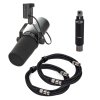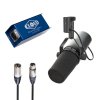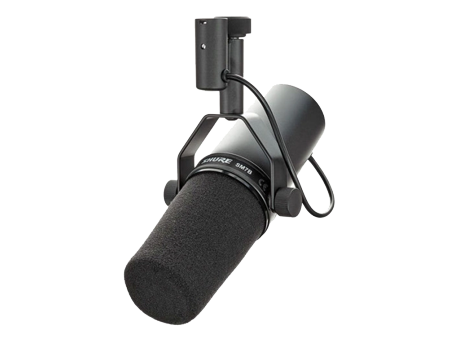Shure SM7B Studio Microphone
€ 368
| GLS - Pick-up-point | €0 |
| GLS - Home Delivery | €10 |
| GLS - Company Delivery | €10 |
Matching accessories:
- Also available as starter pack and vocal pack
- Studio microphone but also perfect as a vocal microphone
- Used for countless professional recordings, such as Michael Jackson's Thriller album
- Handles high sound pressure levels with ease
- XLR connection - cables sold separately
Shure SM7B
A secret weapon of all platinum-winning music producers and legendary radio hosts, but with an affordability for hobby musicians, the studio microphone Shure SM7B is both a classic vocal microphone and versatile studio Swiss Army knife. While many people think of condenser microphones as ideal for recording vocals, the directional Shure SM7B is a dynamic microphone, and has the same shockproof stability as its little brothers - Shure 's SM57 and SM58. Perfect for rousing narration, silky smooth female vocals or getting tones-a-la-hacking from the guitar amp - if you could only have one mic, the Shure SM7B would be an excellent choice. The dynamic studio mic is designed for broadcast use but makes an excellent vocal and vocal mic on any studio recording.
Shure The SM7b is a mic that requires quite a bit of gain - that is, delivers a relatively low output, which can be especially challenging when using it for speech and vocals. If you don't have a preamp with lots of gain (like 80dB), a Cloudlifter is incredibly cool with Shure the SM7B, as it provides 25db of gain, making the mic much more versatile. With a Cloudlifter, it's no problem to record speech or vocals with, for example, the preamp of a Focusrite Scarlett 2i2, which might otherwise fall short with an sm7b in some situations. If you want even more options to customize the Shure sm7b for different purposes, you might want to look at the CL-Z, which has variable impedance, which affects the character of Shure the sm7b and other microphones.
- Type: Dynamic studio microphone
- Frequency range: 50 to 20,000 Hz
- Impedance: 150 ohms
- Cardioid characteristic
- Output level (at 1,000 Hz): - 59.0 dB (1.12 mV), 0 dB = 1 volt per Pascal
- Bass cut-off and mid-range adjustment
- Shock Mount with internal air-sprung shock and vibration isolator
- XLR connection
- Shure SM7B recommended for Studio Vocals, Bass Amp, Podcast/Voiceover and Video/Broadcast
The dynamic Shure SM7B microphone is vocal microphone, for voice-over, radio broadcast, other broadcast and sound recording tasks.
A classic studio microphone yet great for vocals, so the Shure SM7B is used in many contexts as a vocal microphone.
Shure The SM7B is also very suitable for El Guitar, Bass, but also as a drum mic for snare drums
Shure SM7B has become the industry standard for microphones in studios, radio stations, world-class podcasts, and much more. Our expert, Anders Fisker, breaks down the microphone and gives you the full overview of this fantastic microphone.
The basics
Shure SM7B is a dynamic microphone with a cardioid polar pattern. It has a high-pass filter and a mid-range boost filter, which are activated with simple buttons at the end of the microphone.
Additionally, it has a built-in shock mount and comes with two interchangeable windshields. It's a fairly simple microphone, but it has incredibly many applications - and some things to be aware of. But more on that later…
SM7B - a piece of music history
When you read about the Shure SM7B online, you often come across the fun fact that Michael Jackson's Thriller album was recorded using a Shure SM7 (the predecessor to the SM7B), but the story doesn't start with one of the best-selling albums of all time - SM7B was actually not designed for singing.
Without delving deep into the history of the SM7B, it is the successor to the Shure SM5 broadcast microphone from 1966. The classic SM7 was launched in 1974, and the SM7B we know today has been around for over 20 years - it hit the market in 2001 and has been the first choice for radio and studios ever since.
The Swiss Army Knife
But the SM7B can do much more than deliver world-class sound for speech and legendary pop records. In fact, it's one of the most all-around microphones, and there's a reason why it's found in virtually every professional studio in the world.
Vocals:
It almost goes without saying; the SM7B is fantastic for vocals, both speech and singing. Voices vary, and the SM7B is obviously not the perfect choice for all types of vocals, but it's widely used for rock, rap, and more raw pop vocals, where its no-nonsense sound helps place the vocals well in the mix.
Guitar:
A guitar amplifier and an SM7B are a perfect match. Whether it's a crisp stratocaster or a fierce heavy axe. For this purpose, it works really well to remove the built-in pop filter.
Guitar (bonus):
It's not something you see often, but actually, the SM7B is also really cool on acoustic guitar - especially if it's a guitar that doesn't need to be big and lush, but instead needs to bind a mix together and be more percussive than tonal.
Drums:
Bass drum, toms, snare drum, hi-hat, percussion - if you can hit it, you can record it great with a Shure SM7B. It's important to remember to turn off the low cut filter if you're recording a source with a lot of low-end.
Brass:
The SM7B also does great on brass instruments and saxophone - here it also depends a lot on the sound you're going for, but the SM7B's response fits really well with most wind instruments whether it's tuba or kazoo.
Only imagination sets limits, and the sound level
Leslie amplifier, upright piano, accordion - you can record most things with the Swiss Army knife SM7B - where it can fall short is with instruments with very low output and with sound sources far away, but if it's close-mics, it can be recorded with the SM7B.
Why does the SM7B sound so good?
An SM7B has a characteristic sound that you've heard thousands of times without thinking about it. That's also why it's so popular - the easiest way to get that nice radio voice is to use the same microphone as the hosts.
But why does it work so well?
The SM7B has become particularly popular because - compared to condenser microphones - it performs really well in rooms that are not acoustically perfect.
If you use a condenser microphone while sitting at your computer, you'll get a lot of keyboard sounds, blowing noise, reflections from untreated walls, traffic, and much more on the recording - and that's usually not what you want.
A dynamic microphone like the SM7B naturally captures less room noise than a condenser, which is more sensitive - but there are several things that make the SM7B exceptionally good.
Firstly, an important factor when talking about reducing background noise is to be as close to the microphone as possible. That way, the microphone can capture more voice than surroundings - this requires the microphone to have a good built-in pop filter to avoid pop sounds from the air from your voice. The SM7B has a really good pop filter and comes with two interchangeable ones - the normal and an even larger one.
At the same time, the SM7B has a cardioid polar pattern. This means that it primarily picks up sound directly in front of the microphone and to a much lesser extent from the sides.
Some vocal microphones (e.g., Shure Beta58A) have a supercardioid polar pattern, which means they pick up an even narrower field. You might think this would be good for use with a computer, but it's actually not. This is because microphones with a supercardioid polar pattern also pick up a lot of sound from the back of the microphone. It's rarely a problem on stage, but if the microphone is in front of the keyboard, it can be challenging.

Another advantage of the SM7B is that, like a condenser microphone, it captures frequencies from 50 to 20,000 Hz (where SM58 for example only goes up to 15,000 Hz). This matters because you want to capture as much input from the voice as possible, avoiding as much background noise as possible.
Due to the above, there is also no need to buy a reflection filter for an SM7B (it would also be difficult to find one that fits). The microphone simply does not capture enough sound from behind to make any difference.
That being said, you can of course hear the difference between a room with challenges and a well-sounding room - even with an SM7B - but if you use the SM7B correctly, you can get really good results - even in a room that is not acoustically treated.
Connecting to a Computer
If you're going to use the SM7B for podcasting, gaming, speaking, overdubbing, or anything else, you most likely need to get the audio from the SM7B into your computer, either to record it or for streaming.
The SM7B has an analog XLR connector, which cannot be directly connected to the computer. Here, you need to convert the audio from analog to digital - and you do that with an audio interface/external sound card.
The sound card is connected via USB to the computer, and then you can connect the SM7B to the sound card's microphone input. On the computer, you can choose the sound card as the audio source, and voila - you have audio from your SM7B into the computer (if you're on a PC, you may need to install a driver).
A popular sound card for a single Shure SM7B is the Focusrite Scarlett Solo or Scarlett 2i2.
SM7B Challenges and How to Solve Them
Anyone who has worked with an SM7B knows that it's a gain monster. The microphone was designed at a time when radio stations had expensive high-end microphone preamplifiers (preamps) that could easily provide 80dB of gain.
High-end preamplifiers can still do this, but many of the preamps in today's smaller sound cards only deliver 60dB of gain. That's enough for most microphones, but it's not always enough for an SM7B. This is especially true when recording sources with lower output like vocals.
Do you need to go out and buy a +10,000 kroner preamp for your SM7B?
No (although it certainly suits an SM7B well), but fortunately, there's a great-sounding and much cheaper way to get all the goodness out of an SM7B.
There are several so-called 'mic attenuators' on the market, with the most popular being Cloud Microphones' 'Cloudlifter CL-1'.
Simply put, they provide a gain boost, usually around 25 dB, allowing you to treat the SM7B like any other microphone in terms of gain. This provides a cleaner signal if you avoid cranking the preamp in your sound card all the way up because preamps introduce more noise when turned all the way up. If you choose to go with a Cloudlifter CL-Z, you also get variable impedance, which significantly changes the tonality of the SM7B.
SM7B and other recording equipment
If you want to avoid using a computer, there are several good options on the market, where Zoom H5, H6, and H8 are some of the most popular. Therefore, it's natural to ask if these work well with the Shure SM7B - and fortunately, the answer is yes.
You may encounter the same gain challenges as described in the previous section, but it depends a lot on how loudly you speak and how close you have the SM7B to your mouth. If you want some distance, it may be necessary to use a booster (e.g., Cloudlifter CL-1).
SM7B alternatives
Now, I've praised the SM7B to the skies - but of course, there are other microphones that can do some of the same things as the SM7B. Here are a couple of alternatives if you don't want to follow the crowd:
- Shure SM57/SM58: Shure SM57 and SM58 are two of the most widely used microphones in the world. They are dynamic like the SM7B, and you can also get really good speech and vocal sound with them. The SM57 doesn't have a built-in windscreen for vocals, so you'll get the best results with a pop filter or windscreen. Do they sound like the SM7B? No, the SM7B has a fairly unique sound, but both the 57 and 58 are professional microphones that perform very well.
- Electro-Voice RE20: The RE20 is similar to the SM7B in many ways, and which one you prefer will largely be a matter of taste. However, the RE20 is significantly more expensive than the Shure SM7B, but it is an absolutely fantastic microphone.
- Shure MV7/MV7X: Shure has designed these two microphones with clear reference to the SM7B. They are primarily focused on good qualities for speech (podcasts, gaming, speaking, etc.), but can of course also be used for instruments. The difference between them is that the X model has an XLR output, while the regular one has both XLR and USB outputs, so it can be connected directly to a computer.
| Model/Product no.: | SM7B |
| GTIN | 042406088879 |
| Weight (kg) | 1,2 |
- Transducer Type: Dynamic
- Polar Pattern: Kidney
- Switches: Bass rolloff and mid-range weight: slotted response switches.
- Connectors: 3-pin XLR
- Frequency Response: 50 Hz - 20 kHz
- Sensitivity (1 kHz): -59.0 dBV/Pa / 1.12 mV/Pa
- Weight: 765 g
- Includes: Change cover plate, Close-Talk windscreen










